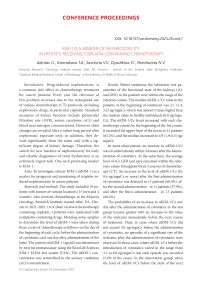KIM-1 is a marker of nephrotoxicity in patients receiving cisplatin-containing chemotherapy
Автор: Alentov I.I., Karmakova T.A., Savchina V.V., Dyoshkina T.I., Marshutina N.V.
Журнал: Cardiometry @cardiometry
Рубрика: Conference proceedings
Статья в выпуске: 29, 2023 года.
Бесплатный доступ
Drug-induced nephrotoxicity is a common side effect in chemotherapy treatment for cancer patients. Every year the relevance of this problem increases due to the widespread use of various chemotherapy (CT) protocols, including nephrotoxic drugs, in particular cisplatin. Standard measures of kidney function include glomerular filtration rate (GFR), serum creatinine (sCr) and blood urea nitrogen concentrations. However, their changes are revealed after a rather long period after nephrotoxic exposure only; in addition, they deviate significantly from the norm only with a significant degree of kidney damage. Therefore, the search for new markers of nephrotoxicity for early and reliable diagnostics of renal dysfunction is an extremely urgent task. One such promising marker is KIM-1.
Kim-1, nephrotoxicity, cisplatin, chemotherapy
Короткий адрес: https://sciup.org/148327403
IDR: 148327403 | DOI: 10.18137/cardiometry.2023.29.conf.1
Текст статьи KIM-1 is a marker of nephrotoxicity in patients receiving cisplatin-containing chemotherapy
Moscow Research Oncology Institute named after. P.A. Herzen - branch of the Federal State Budgetary Institution “National Medical Research Center of Radiology” of the Ministry of Health of Russia, Moscow
Introduction . Drug-induced nephrotoxicity is a common side effect in chemotherapy treatment for cancer patients. Every year the relevance of this problem increases due to the widespread use of various chemotherapy (CT) protocols, including nephrotoxic drugs, in particular cisplatin. Standard measures of kidney function include glomerular filtration rate (GFR), serum creatinine (sCr) and blood urea nitrogen concentrations. However, their changes are revealed after a rather long period after nephrotoxic exposure only; in addition, they deviate significantly from the norm only with a significant degree of kidney damage. Therefore, the search for new markers of nephrotoxicity for early and reliable diagnostics of renal dysfunction is an extremely urgent task. One such promising marker is KIM-1.
Aims : To investigate urinary KIM-1 (uKIM-1) as a marker for prognosis and monitoring of cisplatin-induced nephrotoxicity in cancer patients.
Materials and methods . The study included 19 patients with tumors of various locations (15 men and 4 women), who received chemotherapy at the Moscow Oncology Research Institute named after. P.A. Herzen in 2021-2022. 16 of them received chemotherapy containing cisplatin, 3 patients were medicated with oxaliplatin-containing drugs. Morning urine samples to determine the level of uKIM-1 were taken during three cycles of chemotherapy as follows: on the day of the beginning of each cycle, before the administration of cytostatics, and one day after administration of the latter. The content of uKIM-1 (ng/ml) was determined by enzyme immunoassay using the EnzoLife Sciences KIM-1 ELISA test system (USA). The uKIM-1 concentration was normalized to the urinary creatinine (uCr) concentration.
Results . Before treatment, the laboratory test parameters of the functional state of the kidneys (sCr and GFR) in the patients were within the range of the reference values. The median uKIM-1/Cr value in the patients at the beginning of treatment was 2.1 (1.4; 3.2) ng/mguCr, which was almost 3 times higher than the median value in healthy individuals (0.8 ng/mgu-Cr). The uKIM-1/Cr levels increased with each chemotherapy course; by the beginning of the 3rd course, it exceeded the upper limit of the norm in 12 patients (63.2%), and the median increased to 4.9 (1.9; 6.5) ng/ mguCr.


